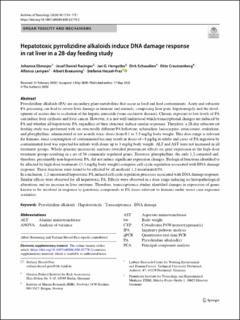| dc.description.abstract | Pyrrolizidine alkaloids (PA) are secondary plant metabolites that occur as food and feed contaminants. Acute and subacute PA poisoning can lead to severe liver damage in humans and animals, comprising liver pain, hepatomegaly and the development of ascites due to occlusion of the hepatic sinusoids (veno-occlusive disease). Chronic exposure to low levels of PA can induce liver cirrhosis and liver cancer. However, it is not well understood which transcriptional changes are induced by PA and whether all hepatotoxic PA, regardless of their structure, induce similar responses. Therefore, a 28-day subacute rat feeding study was performed with six structurally different PA heliotrine, echimidine, lasiocarpine, senecionine, senkirkine, and platyphylline, administered at not acutely toxic doses from 0.1 to 3.3 mg/kg body weight. This dose range is relevant for humans, since consumption of contaminated tea may result in doses of ~ 8 µg/kg in adults and cases of PA ingestion by contaminated food was reported for infants with doses up to 3 mg/kg body weight. ALT and AST were not increased in all treatment groups. Whole-genome microarray analyses revealed pronounced effects on gene expression in the high-dose treatment groups resulting in a set of 36 commonly regulated genes. However, platyphylline, the only 1,2-saturated and, therefore, presumably non-hepatotoxic PA, did not induce significant expression changes. Biological functions identified to be affected by high-dose treatments (3.3 mg/kg body weight) comprise cell-cycle regulation associated with DNA damage response. These functions were found to be affected by all analyzed 1,2-unsaturated PA. | en_US |
